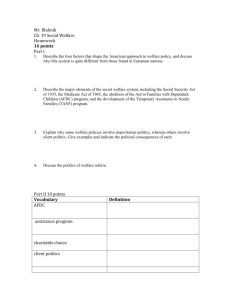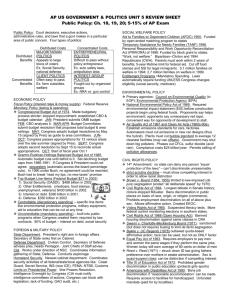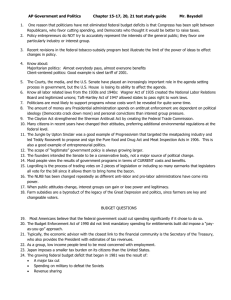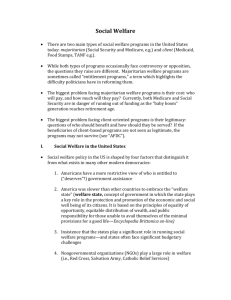Chapter 17: Social Welfare
advertisement
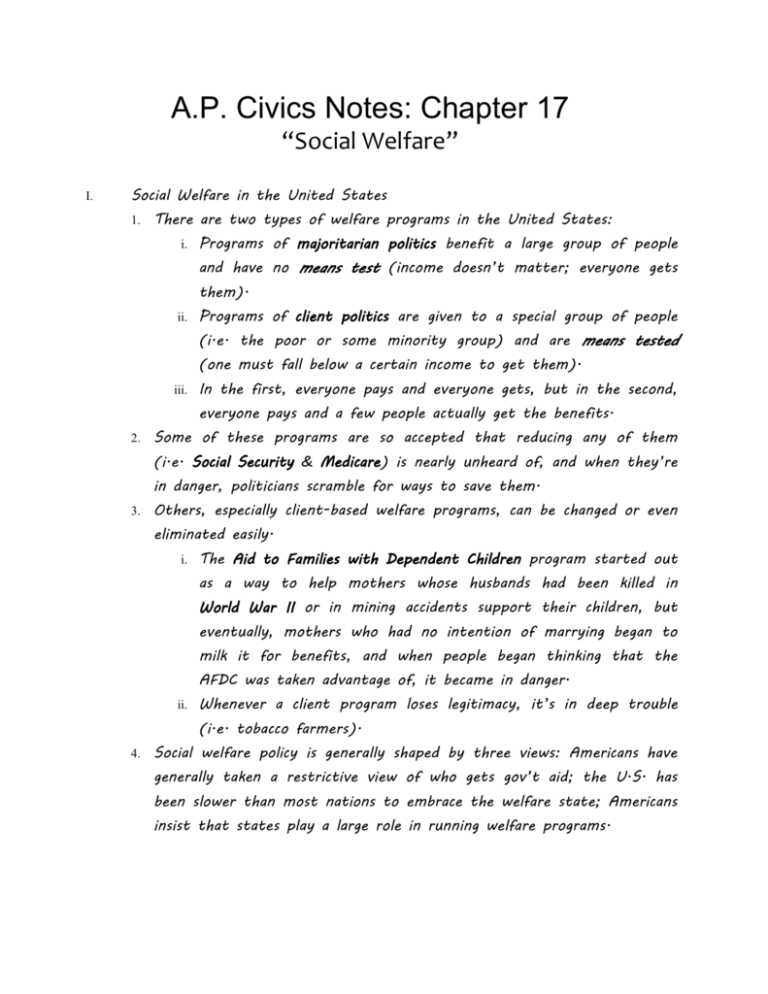
A.P. Civics Notes: Chapter 17 “Social Welfare” I. Social Welfare in the United States 1. There are two types of welfare programs in the United States: i. Programs of majoritarian politics benefit a large group of people and have no means test (income doesn’t matter; everyone gets them). ii. Programs of client politics are given to a special group of people (i.e. the poor or some minority group) and are means tested (one must fall below a certain income to get them). iii. In the first, everyone pays and everyone gets, but in the second, everyone pays and a few people actually get the benefits. 2. Some of these programs are so accepted that reducing any of them (i.e. Social Security & Medicare) is nearly unheard of, and when they’re in danger, politicians scramble for ways to save them. 3. Others, especially client-based welfare programs, can be changed or even eliminated easily. i. The Aid to Families with Dependent Children program started out as a way to help mothers whose husbands had been killed in World War II or in mining accidents support their children, but eventually, mothers who had no intention of marrying began to milk it for benefits, and when people began thinking that the AFDC was taken advantage of, it became in danger. ii. Whenever a client program loses legitimacy, it’s in deep trouble (i.e. tobacco farmers). 4. Social welfare policy is generally shaped by three views: Americans have generally taken a restrictive view of who gets gov’t aid; the U.S. has been slower than most nations to embrace the welfare state; Americans insist that states play a large role in running welfare programs. i. Who benefits usually means who “deserves to benefit;” and that is usually people who are unemployed or have fallen on hard times and cannot work (i.e. disability, etc…). ii. There’s also a question of a “fair share” in which those w/ a lot of money give some to those who have a little, but in America, that is usually not the case. 5. Americans believe that people should be self-reliant and that people who work hard get what they deserve; they are also uneasy about giving money to people, preferring to offer services instead. 6. When Congress passed the Social Security Act in 1935, at least 22 other European nations had already done so, as did Australia and Japan i. The British were one clear contrast: during the early 1900s, the in-power group was focused on making welfare a top issue, and people were beginning to encourage such gov’t actions. ii. In America, though, even the Progressives called for reform, not the introduction of new ideas. 7. Furthermore, since the Constitution had never said anything about Congress spending money on welfare, it was not until the 1930s that a reinterpretation encouraged Congress to do so. i. Between 1923 and 1933, though, 30 states enacted some form of an old-age pension, though, and by 1935, all but two had adopted a “mother’s pension” given to widows who were “fit mothers” and ran “suitable homes.” ii. Eventually, federal welfare programs used state programs as their bases. 8. Before the Great Depression, there were relatively few welfare programs, and most of the existing ones were geared toward widows, orphans, or the elderly, but upon the election of Franklin D. Roosevelt, Congress sprang to enact emergency legislation to help out the massive unemployed. i. Most of them were short-term, though, and for long-term programs, FDR created the Cabinet Committee on Economic Security, which used European models and adapted them to America. ii. Meanwhile, people like Huey Long, who proposed the “Share Our Wealth” plan, Upton Sinclair, and Dr. Francis E. Townsend, who demanded monthly $200 pensions for old people, were generating new ideas and gaining popularity. iii. The plan that the cabinet committee came up with called for an insurance program for the unemployed and elderly (workers paid to get benefits later) and an assistance program for the blind, dependent children, and the aged, both of which would be funded by taxes. a. Only the poor could be helped by the assistance programs, and they had to pass a means test to determine their income and eligibility. b. This Social Security Act swept through Congress and was signed in August of 1935. 9. A national health care plan was left out of the act, but people still pursued it, even other some politicians and groups like the American Medical Association disliked it, called it “socialized medicine,” and believed it to be either wrong in principle or just too expensive. i. The elections of 1964 brought a landslide of national health planfavoring Democrats into Congress (especially in the Ways and Means Committee, which had opposed it with the lead by Wilbur Mills before), and eventually, a system emerged, called Medicare. ii. It would only apply to the aged, cover hospitals, not doctors, but also gave coverage to the poor (called Medicaid) and helped the aged pay doctors bills, but it still passed. 10. Congress left most of the implantations of the AFDC to the states, but it did increasingly pass certain regulations on the program to help single or widowed mothers raise their children. i. AFDC recipients could also become eligible for Food Stamps, the Earned Income Credit (cash grants to the working poor), free school meals, various forms of housing assistance, and certain other benefits, but at the same time, public opinion was growing against the program. ii. Many people complained about different things about it, and most felt that it encouraged out-of-wedlock births, since more babies meant more money/benefits; it was cheap!!! II. Two Kinds of Welfare Politics 1. A proposed programs will generally pass if the benefits are less than their costs and if political elites believe that it is legitimate, but Social Security initially gave each person who qualified more money that each person who paid actually paid. i. This was okay, though, since at that time, the rate was small anyway, and there were so many young people that they could offset the cost and pay for Social Security. ii. Some people even vastly underestimated the costs, but today, the situation is different, since there are more elderly people than ever, and the number of people who can pay for Social Security and Medicare is starting to be not enough. 2. With Social Security and Medicare, the argument was over their legitimacy, and whether they were authorized by the Constitution and/or really needed that bad that the gov’t had to pay for them. i. Since the creation of Social Security and Medicare, it is rare that Congress does not increase benefits, since Congressmen want to be re-elected, and what better to get votes than to give people more benefits? 3. These days, there are less and less people to pay for Social Security, people are growing older, and health care costs have shot up, so Social Security and Medicare are now in danger of being illegitimate. 4. Proposals that are in client politics will generally pass if the costs aren’t that great and the beneficiaries are “deserving.” i. The AFDC still doesn’t cost that much, but its recipients are no longer being considered “deserving,” and instead of money, people now favor a service strategy (training people to work in certain jobs and giving them skills) over an income strategy (giving them money). 5. Some argue that welfare actually increases poverty because it’s easier and more attractive to go on it. III. Towards a New Welfare Politics 1. Majoritarian politics problem: who will pay; how much will they pay? Client politics problem: who should benefit; how much should they be served? 2. In 1981, people feared that Social Security would soon run out of money, and to solve this, eventually, a non-partisan group raised SS taxes, slightly decreased benefits, and increased the minimum age that people had to be to get benefits from 65 to 67 years old. 3. To solve runaway Medicare costs, Congress has tried to regulate what doctors and hospitals can and cannot charge onto Medicare, but some argue that price controls won’t work. i. One way was to have people pay a flat fee no matter what the injury, whether it be a broken bone or a brain tumor, and hospitals could pay for more expensive operations themselves and/or pocket the money on cheaper services, depending on the situation. a. Many simply reduced the quality of their services, though, treating patients worse. 4. In 1988, Congress passed the Medicare Catastrophic Coverage Act, which let the gov’t pay for all costs of any catastrophic illnesses (strokes, etc…) after a person paid a deductible, but critics never felt it helped anyone, and it was repealed 18 months later. 5. The Medicare problem still has not been solved, since people don’t know how much funds to cut off from the hospitals, and even that won’t help, since hospitals will either lower service or charge paying customers more, and they won’t like that either. 6. For Social Security, Congress has proposed to let part of Social Security be invested in stocks, but old people don’t like it because it’s risky; when costs go up, majoritarian politics is no longer easy. 7. It’s easier to deal with client politics that lost legitimacy: the Personal Responsibility and Work Opportunity Reconciliation Act of 1996 abolished the national AFDC, let states run welfare programs for the poor as they saw fit, w/o gov’t regulations (each state did get federal block grants to pay for Temporary Assistance for Needy Families, though), makes beneficiaries look for work by limiting the time of benefit getting, and denies food stamps to legal aliens and TANF for illegal aliens. i. TANF beneficiaries must be working within two years, and under18 mothers can only get TANF if they live with a parent and attend school. 8. There is a lot of argument over homeless people: liberals say there are a LOT of them, that they’re mostly victims of high housing costs or social services cuts, and that the gov’t should at least stop harassing them and at most give them shelter; conservatives say that there are few homeless people, and those that are homeless are mentally ill or drug addicts who should be sent to institutions or jailed. i. Most cities arrest for public disorder but not sleeping on the streets, give shelters only in cold weather, and offer but don’t require treatment to mentally ill or drug-addicted people. 9. Many immigrants to the U.S. are illegal (usually from China, Mexico, and Haiti; usually go to California, Florida, Texas, Illinois, New Jersey, & New York), unskilled, and believed to either take away jobs from the people where legally or drain billions of dollars in benefits programs. i. Illegal aliens are NOT among America’s “deserving poor.” ii. Most immigrants are neither part of the “pitiable, huddled masses” or the “job-stealing aliens,” but recent laws have cut off benefits to illegal aliens. iii. How they will be dealt with remains to be seen.
